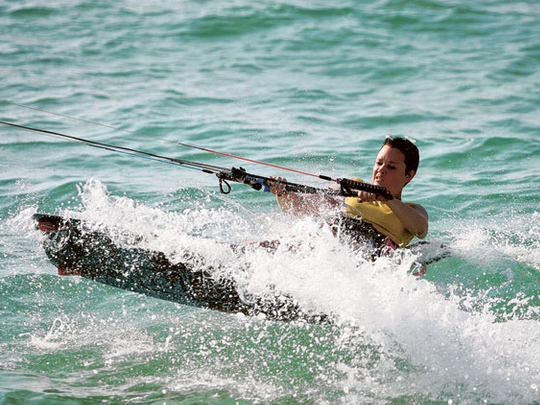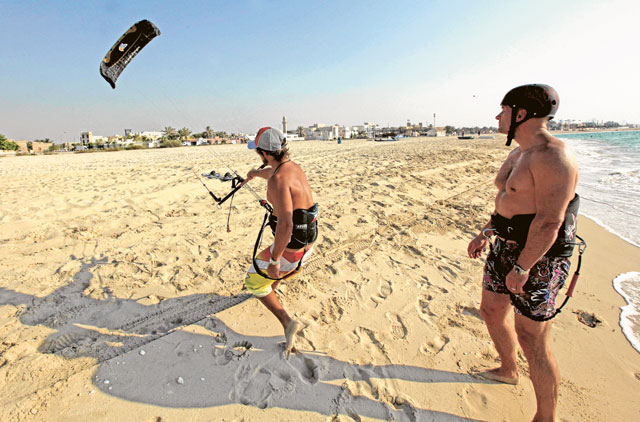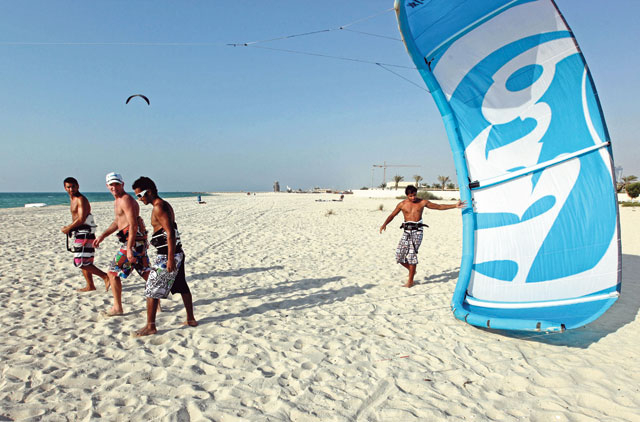
Dubai: It's half past four on a Monday evening and the glare of the September sun is still strong. It isn't that windy, which means it isn't one of the best days for kite surfing. Yet there are enough enthusiasts to make the kite surfing beach strip on Jumeirah Beach Road come alive.
"On a good windy day, you will find 60-70 kites in the air," says Alex Dandachli, an instructor of the Dukite club, as he surfaces from the shimmering blue sea with student Katie Laing. "I have completed my training on the beach and am now getting on the kite board," says Laing, an Irish visitor.
A few metres away, Mark Richards, another instructor, is taking a class for Kevin Clints whom he describes as being at the "intermediate" level. "This is my fourth lesson and I find it a perfect balance from business," says Clints, who is from an oil and gas services background.
Surf's up
There are many others, including a 14-year-old French boy, Baptiste Aubuorg, and his little brother and a group of students from the American University of Dubai. "We love the idea of kite surfing, the hang time we get, the freedom that the beach offers," says Mubarki, one of the students.
Clearly, kite surfing is all the rage in Dubai. "The kite surfing community in Dubai has around 3,500 people. Of them, around 1,800 are regulars," said Mustafa Al Hussaini, owner of the Dukite club which offers classes for both beginners and advanced learners.
"The support and location for kite surfing has been provided to us by the Crown Prince of Dubai [Shaikh Hamdan Bin Mohammad Bin Rashid Al Maktoum]," he says, adding that beach facilities include first aid, police rescue, showers, changing rooms, drinking water and soft drinks on purchase, besides volleyball and soap football courts.
Waves of excitement
Classes at Dukite range from basic orientation to advanced skills. As Dandachli explains, beginners get to learn with a baby kite that is two or three metres in size. "When they pick up the basic techniques to control a kite, we move on to set up and safety lessons with a big kite on the beach."
Once that is learnt, students are good to move to the water for body dragging and re-launch of the kite from the water. The next step is to move on the board to face the wind and the waves.
"People love to surf the waves with the kite, do tricks or just cruise on the beach," says Aubuorg. Living across the road, the 14-year-old has been kite surfing for the past one and a half years.
The "young champion", as everyone calls him, recently suffered a fracture in his right hand after falling down from his cycle but he is still on the beach to do some ‘power kiting'.
Craig Traynor, a third instructor, says the number of lessons that one requires depends on the student. "Normally, training to be a kite surfer and do kite boarding in the water would take six to eight lessons."
While there is no membership fee for the club, charges for lessons are on an hourly basis and also depend on whether it is one-to-one or a group session.
What is Kite Surfing?
Kite surfing or kite boarding is an adventure surface water sport that harnesses the power of the wind to propel a rider across the water on a small surfboard or a kite board. Riding styles have evolved to suit riders and conditions, such as free style, wake style, wave riding, jumping and cruising.
The basic requirement for kite surfing lessons is to be able to swim in the sea.











